Former Head of S-21 Photography Unit Testifies
Former head of photography unit at S-21 Nhim Kim Sreang gave his testimony today. He gave evidence with regards to the procedure of taking photographs of incoming prisoners. He also told the court that former photographer and witness Nhem En had largely overstated his importance at the prison. He also cast doubt that Nhem En ever went to China for photography training prior to his arrival at S-21.
Preliminary questions: Nhim Kim Sreang
Technical issues at the beginning of the day delayed the testimony of the witness for a few minutes. Noem Oem, alias Nhim Kim Sreang was born in 1953. The Nuon Chea Defense Team requested to hear the witness for 1.5 days at least instead of the scheduled one-day testimony. The Co-Prosecution said that the witness was not as important as Him Huy for example, but that they would not object to an extension of his testimony, as he was the chief of the photography unit at S-21.
The floor was then handed to the Defense Team to examine the witness. Mr. Koppe first asked him whether he had been informed of the right to a duty counsel, which the witness denied. Mr. Koppe pointed out that Him Huy, Suos Thy, and Tay Teng had the assistance of a duty counsel and addressed the Chamber by saying that he did not know why this witness had no duty counsel. He then asked about Mr. Kim Sreang’s imprisonment imprisoned of ten years, which the witness said was not related to his role at S-21. Instead, he explained that he had tried to stop people fighting. As a consequence, these people became aggressive and seemed to attack him. He grabbed a stick and hit a person.
As for his time under the Khmer Rouge, he confirmed that he was wounded at some point when he was still at Battalion 12. He was asked by Ta Nath to be trained in photography. He had a team of six persons, who all came from Division 703. “I was so scared”.
Nhem En
He was the group leader of Srung Song and Kang Nith. Ta Nath drove the three to S-21. Mr. Koppe quoted his statement, in which he had said that there were no photographer at S-21 when he first arrived.[1] The witness confirmed this. Mr. Koppe inquired whether he recalled Nhem En, or Little En. He said that he could recall him. “When those children were brought in by Nath, I saw amongst those group of children […] some of my relatives”. He did not teach them all of his expertise, since he knew that “the expert would be killed” once the younger ones had learned everything. Mr. Koppe presented a photograph to him that showed a photograph of a young person. [2] He said that Nhem En was young at the time and that he had not met him anymore since then. “I heard only his voice on the radio”.
Mr. Koppe inquired whether Nhem En had advanced photography skills when he arrived. Mr. Kim Sreang denied this firmly: “Although he boasted about his photography session in China, how could that happen, since he could not even put the film properly?”
Mr. Koppe read out an excerpt, in which Nhem En had said that he was the chief of the photography unit and was the chief of six people, including a person called Sreang. Mr. Kim Sreang replied that “that was cheating!”[3] Mr. Koppe said that Sreang was the chief of the photography unit and that Number 2 was Song.[4] He confirmed that “Nhem En had no role to play”. He came to study photography. “As myself, I did not have any authority to wander around. I was sent to take the photographs of the prisoners”. Nhem En, he said,
stayed outside the compound.
Mr. Koppe moved to the next topic and asked what the witness’s task were. He answered that his main role was to take photographs and develop the films. They developed the photos in the house that he lived. Mr. Koppe presented a photograph from the surrounding of the Tuol Sleng museum from above and on which 22 houses were shown on a separate photograph next to the map.[5] He said that he lived in the house that was circled in yellow. Duch’s house was circled in orange, he said.
The chemicals, films and papers were stored in the developing room. Only three people lived there. Nhem En never slept there. “I did not even allow him to enter the developing room”. The most important thing was to cleanse the negatives. Mr. Koppe said that he had explained that a few times photographs were damaged and had to make the photographs from the negatives again.[6] Mr. Kim Sreang confirmed this.
At this point, the President adjourned the hearing for a break.
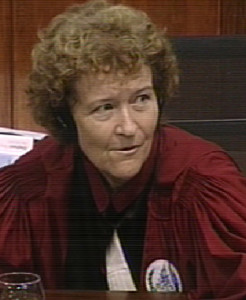
Judge Claudia Fenz
The Trial Chamber did not grant the request of the Nuon Chea Defense Team for extra time, since this would have “a big impact” on scheduling. Judge Fenz explained that the request was quite late and that this would pose difficulties on scheduling upcoming witnesses. Mr. Koppe promptly responded: “That’s utter nonsense and you know it”. Judge Fenz reminded him to “watch your language”, which Mr. Koppe refused: “I will certainly not watch my language”. He addressed the judges by saying that the witness was very important “and you just say no?” Judge Fenz instructed him to make a “reasonable request” if he disagreed with the decision.
Mr. Koppe then read an excerpt of Nhem En, in which he had said that he was the head of the photography unit, because he was the most knowledgeable one. The witness reacted to this: “I felt it’s a joke, because Nhem En was too young at the time, and he said that he had been sent to study in China. I do not believe at all that he knew or possessed such skills, because he was too young”. He said that Nhem En must have been lying, because he had no knowledge when he arrived at S-21. He did not believe that he was sent to China for learning photography prior to arriving at S-21.
Photographs
Mr. Koppe presented a binder of photographs that the witness was asked to “scroll through” them.[7] Ms. Kim Sreang said that they looked like the ones taken at S-21. They sent the photographs to Thy after developing them. He said that he was probably the one who made the annotations on the back of the photographs. Suos Thy was the one who sorted the information as to the entry date and names. Mr. Koppe said that Nhem En had told the court that it was Kim Sreang’s handwriting, which the witness refused to accept. He explained that this did not lay in his responsibility. He said that there was no set system for the numbering system on the photographs of prisoners.
Mr. Koppe quoted the witness’s statement, in which he had said that sometimes he waited for more prisoners to arrive to not waste a film roll.[8] Mr. Kim Sreang confirmed this. They had to keep the film roll in the camera until they fully used them.
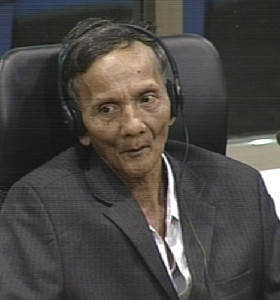
Witness Nhim Kim Sreang
Mr. Koppe asked Mr. Kim Sreang to ask how the numbering system changed.[9] The witness explained that it changed in late 1978. Duch instructed them to take one photograph from the front and one form the side and introduce the entry date. The system was “an individual system”, he said. “There is no fixed date and numbering system to identify the total number of prisoners”. It was difficult to recognize what was done by Song and Nhit. During the later parts of the year, Mr. Kim Sreang took photographs only sometimes. The prisoners with caps were either staff members or prisoners who were brought in at the early stage of the prison, because they had no number tagged on them.[10] Mr. Koppe then wanted to know what would happen if photographs were damaged. He answered that it was not a problem if it was the developed photograph that was damaged, because they could then be reproduced. It was a problem if the negatives were damaged. There were cases where they had to retake photographs of the prisoners, for which they had to seek permission from Suos Thy.
Mr. Koppe read an excerpt of the witness’s interview.[11] The witness could remember having gone to the rice fields (in Prey Sar) when the photographs were damaged and re-taken the photographs there. He did not know where the prisoners were sent to after developing the photographs.[12] Thousands of people worked in the rice fields. The people who were sent to Prey Sar were those who were subordinates and played only a minor role.
Him Huy had told the court that some prisoners were first sent to S-21 and then to Prey Sar “to work the field”.[13] Duch assigned him to retake those photographs that were damaged.
At this point, the presiding judge Ya Sokhan adjourned the hearing for the lunch break.
Children at S-21
After the break, Mr. Koppe inquired about an instance of rape. He recounted an instance of rape: a medic had raped a prisoner.[14] The medic was imprisoned and executed.
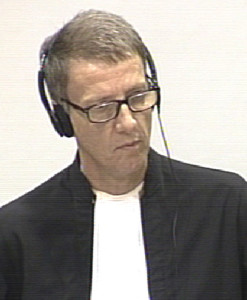
Nuon Chea Defense Counsel Victor Koppe
He took the photograph of two journalists who were either from Cuba or Russia. The camera was either a Pentax or a Canon.[15] Mr. Koppe asked whether it was correct that he never photographed any children, which the witness confirmed. He was only called to take photographs when there were large numbers of people being brought in. He did not know how many children there were and whether his estimate of 10 percent was too high. When Mr. Koppe asked whether there were between 1.5 and 5 percent children in the prison, Senior Assistant Prosecutor Dale Lysak object and said the question was leading. The witness said that he did not see hundreds of children. The children were brought in with their parents. He did not see children at Prey Sar.
Hor was the deputy chief of the prison. He was blind on one eye. They escaped to the mountain together. He did not pay attention to their roles and only received orders from them. Everything else was a matter, he said, between “them” and the Ministry of National Defense.
When Mr. Koppe sought more detail about the tasks of Duch and Son Sen and presented excerpts to him, Mr. Kim Sreang said that he did not know more about it.[16] As for Sry, Mr. Kim Sreang said that he was a senior cadre who asked for cadres.
Mr. Koppe asked whether Sry held Mr. Kim Sreang’s task when it came to the “important prisoners”. He confirmed this.He took photographs of Vietnamese soldiers. He went to the Beehive Radio Station in August, but could not recognize it. He remembered that it was close to the sewage canal, but the surrounding had changed “dramatically”, he said. He went there with historians in August of this year. “He asked me to go with me to tell him about the location”.
Submissions Regarding the Calling of 2-TCW-1065
Judge Ya Sokhan then invited submissions and responses with regards to the calling of 2-TCW-1065 in relation to armed conflict. The Co-Prosecution said that this witness was important and should therefore be called. The International Civil Party Lead Co-Lawyers relied on the court’s discretion.
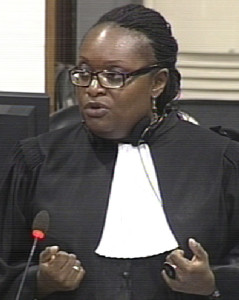
Khieu Samphan Defense Counsel Anta Guissé
The Khieu Samphan Defense Team strongly objected to calling the witness. Ms. Guissé explained that although new elements could be introduced under Rule 87 (4), it should be considered that it was very late in the trial process. She said that they could not understand the decision to call this witness, seeing that no party had requested it. Moreover, this witness was not sufficiently important to justify this, she said, and other witnesses would be at a better place to be called. For example, 2-TCE-87 should have been called instead. “We’re very uncomfortable”, she said. They had to re-adapt to new evidence each day. However, if the Chamber decided to call the witness, she said that the Khieu Samphan Defense Team requested sufficient time to prepare as well as to receive the audio-tapings that correspond to the Written Record of Interview.
Victor Koppe said for the Nuon Chea Defense Team that some context had to be given. The witness in question was a distant family member of East Zone leader Sao Phim and a medic at hospital belonging to East Zone Division 4 that was run by Heng Samrin. He was therefore not as important as other witnesses, such as Heng Samrin and other that had been requested by the Nuon Chea Defense Team. He pointed to the dissenting opinion of Judge Van den Wyngaerd in the Katanga case, in which she had elaborated on the problem of missing evidence.
As a reaction to the statements by the two defense teams, Mr. Lysak stated for the Co-Prosecution that he wanted to “just respond to the incredible things we just heard”. He pointed out that the witness was a chairman of the regiment hospital and that he was promoted to regiment commander when “everyone else was purged”. Mr. Lysak sad that he could not believe “for the life of me someone saying that this was not a significant person”. As for the procedural grounds, he said that they were trivial objections. Enough time to prepare for this witness could be prepared. Ms. Guissé responded that the Co-Prosecution apparently did not consider the witness as “so important” since they had not requested to call the witness. Moreover, she stressed that it was already September 15, 2016 today.
The Co-Prosecution then took up the questioning again. Mr. Lysak inquired what he was assigned to photograph while he was in Division 703. He explained that he “disliked the way [he] was treated” when he was wounded. They were discriminated and, for example, given less food. When he could walk again, he went to the common dining hall. He was warned that he had to be more careful about complaining, since he would otherwise get injections and die. In the afternoon a medic came to give him an injection, which he refused. This was the day that Phnom Penh fell. He was taken to Ta Nath’s location by his messenger and was assigned to be the photographer of Division 703 subsequently. He said that “this was to keep us archived”.
The people who taught him photography were introduced to him by Ta Nath. They sought help through him to find people who could translate the foreign language on how to use the camera. [17]
At this point, the President adjourned the hearing for a break.
Procedures
After the break, Mr. Lysak asked about the procedure of taking photographs of prisoners. Mr. Kim Sreang answered that they took photographs of incoming prisoners, but did not have the right to enter the room where “important prisoners” were taken to. After photographing them, they were brought to the detention building at S-21. He would keep the film roll until it was fully used. He personally delivered the photographs to Suos Thy. The negatives were stored in Mr. Kim Sreang’s room. They stored the negatives in an air-conditioned room in a sequential order. A roll of film would have 36 shots, and they would use all of them before developing them.
Mr. Lysak presented photographs to the witness. Mr. Kim Sreang recognized the location as the place where Ty registered the prisoners.[18] It was a large room where women were detained. They used letters first and later numbers.
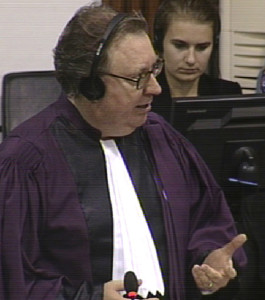
International Senior Assistant Prosecutor Dale Lysak
Mr. Lysak wanted to know what the mechanic device was that could be seen on the photograph.[19] He replied that the instrument could be used to steady the head and was sometimes used to measure the height of prisoners. Mr. Lysak showed a montage of photographs.[20] He answered that they did not take many photographs of prisoners on chairs, since taking photographs from the front and the side took more space on the film and more time. The photograph was taken at Ty’s place. He went there twice approximately. In the room, people were not handcuffed or chained. In individual cells, both legs and hands were shackled.
Asked about another photograph, he said that prisoners were not taken downstairs. He brought his camera along and the necessary equipment. In that photograph, prisoners were shackled in their individual cell.
The next photograph shown to the witness showed a prisoner who was handcuffed to another person.[21] Mr. Kim Sreang explained that it was taken at the location where Ty worked and that the person had just arrived. The person who was standing on the photograph, he said, was waiting for his turn to be photographed. The next photograph showed a person with his hand tied behind his back. Mr. Kim Sreang said that it was likely that this person was not handcuffed and that he was therefore tied to a rope. They did not write on the negatives themselves, but only on the wooden bars.[22] Nith and Song could not write well, so they asked for help of other people. The witness himself could write well. He sometimes assigned Nith to take photos. Each month, ten times the number of prisoners were brought in. On some occasions, the films were all damaged.[23] If only one or two prisoners were brought in, he would assign his subordinates to take the photographs. Some deceased prisoners were photographed. Ty called him to come. It was reported to Duch that the prisoners had been beaten to death and Duch told him to take the photographs of dead prisoners.
Mr. Lysak showed two photographs of prisoner Voeuk Peach: one mugshot and one postmortem photograph.[24] To his knowledge, the person of the second document died in the building, but his body was carried outside of the building. The prisoners could be found in the S-21 List.
Mr. Lysak then asked about Nath who was not arrested until 16 December 1978, while he had said that Nhem En came two months after Ta Nath’s arrest.[25] He explained that he never saw Nhem En before he came to receive training by him.
The President adjourned the hearing. It will continue tomorrow, September 16, 2016, at 9 am with the testimony of this witness, followed by 2-TCCP-283.
[1] E3/7639, at 00162733 (EN), 0062709 (KH), 00338076 (FR).
[2] E3/10600, at 001622874 (EN), Annex a.
[3] E3/7495, at 00078256 (EN), 00826558 (KH), 00795351 (FR).
[4] E3/7457, E3/7468; E3/5783, 27 April 2009.
[5] E3/10603, at 00210940 (EN).
[6] E3/7639, at 00162736 (EN), 00338079 (FR), 00162713 (KH).
[7] E3/9214a.
[8] 00162714 (KH), 00338080 (FR).
[9] P01223764.
[10] P01223835.
[11] E3/7639, at 00162734 (EN), 00162710 (KH), 00338076 (FR).
[12] E3/7639, at 00162736 (EN), 00162713 (KH), 00338079 (FR).
[13] Testimony of Him Huy, 13 May 2016.
[14] E3/7639, at 00162715 (KH), 00338083 (FR).
[15] 00162735 (EN), 0033808 (FR), 00162712 (KH).
[16] E3/5748, at 0013445 (FR), 00153459 (KH). E3/1570, at 00154193 (EN), 00154223 (FR), 00154208 (FR), E3/5792; E3/5771, at 00185500 (EN), 00185492 (KH), 00185509 (FR).
[17] E3/7639, at 00162708 (KH), 001627032 (EN), 00338074 (FR).
[18] E3/8639.4426; .5089 ; .4926; .4724 ; .5184 .
[19] E3/8639.193; 196;.4149 ; .4192 ; E3/8063.74.
[20] E3/8063.74.
[21] E3/8639.3319; .3321 ; .3813.
[22] E3/8639.1064.; .4 ; .48 ; .386 ;.703.
[23] E3/7639, at 00162714 (KH), 00162738 (EN), 00338081 (FR).
[24] Davis Chandler: Voices from S-21; E3/1684, at 00192764 (EN); E3/8063.49; S-21 List of Prisoners who Died of Disease on October 12 1977, E3/3181, at 00088691 (KH), 00784614 (EN), 00728981 (FR).
[25] At 00162734 (EN), 00338077 (FR).
Featured Image: Witness Nhim Kim Sreang (ECCC: Flickr).
